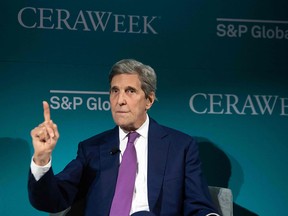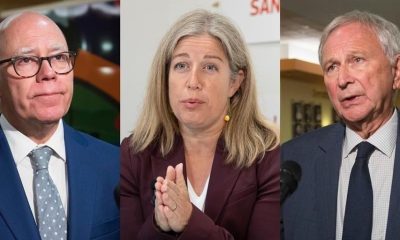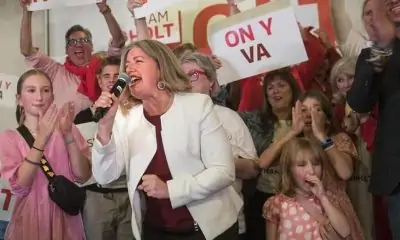The annual CERAWeek meeting is underway in Houston, promoted as the world’s “premier” annual climate and energy event where a parade of corporate and political heavyweights, such as U.S. climate czar John Kerry, spar over the future of the global energy system.
Economy
Terence Corcoran: Shattered windows and the broken economy fallacy
Smashing carbon energy will not bring a ‘just transition’ to better growth

A famous economic parable from the work of French economist Frederic Bastiat in 1850 outlines what is known in economic circles as the Broken Window Fallacy. In the parable, a boy smashes the window in a town shop, creating an expense and loss for the shopkeeper. But a bystander observes that there is an economic benefit to smashing windows: Glassmakers get more business, a conclusion glibly summarized in one commentary: “It’s a good thing to break windows — money gets circulated and the industry thrives.”
That’s the fallacy: Destructive acts of man or nature create economic opportunity that trumps the loss. Even acts of war have big payoffs. The Second World War has often been seen as the catalyst for American prosperity and a model for governments today. Why not use the same government interventions and policies to mobilize industry and the private sector to reshape the economy to fit some new pre-conceived idea of economic perfection. We don’t have a war, but we could act as if we had a war.
At CERAWeek, Kerry is reported to have dragged in the war-climate analogy, calling for a global mobilization to fight climate change. It was a milder replay of his claim earlier this year that the global effort to achieve net-zero carbon emissions was comparable to fighting the Nazis; it requires setting the global economy on a war footing.
Bastiat, in his summary of the original broken window parable, said his story “contains an entire theory … which, unhappily, regulates the greater part of our economical institutions.” That was 1850, but it’s even more true in 2023 as governments in the Western world attempt to smash the windows of the energy system and replace it with an all-new net-zero energy regime.
The broken window fallacy in such thinking, if I can presume to condense Bastiat, is that the real cost of breaking windows is ignored. The window repair company will make $2,000 from the repair costs and the new spending will be incorporated into GDP as a source of growth. Missing in that summary is the fact that the shop owner has lost $2,000 and has nothing to show for it. He has, moreover, lost the opportunity to buy $2,000 worth of clothing for his kids or to invest in a new lunch counter that would increase his shop’s sales and his income.
If window smashing advances the economy, why not break millions of windows and see their replacement as a source of growth — the production of glass, frames, manufacturing, distribution, installation? That, unfortunately, is exactly the plan now being proposed by the build-back-better proponents and the great net-zero energy resetters at the helm of Canada’s just transition plan and the industrial subsidy regime now being installed in the United States.
Theorists such as Mark Carney see the push to carbon net-zero, through the massive reduction in fossil-fuel use, as a golden growth opportunity. “If you are making investments, coming up with new technologies, changing the way you do business, all in service of reducing and eliminating that threat, you are creating value.”
When Ottawa recently outlined its “just transition” action plan to achieve net-zero by 2050 the overriding message could have been taken from Bastiat’s parable. Governments, workers and industry need to join together to harness the opportunity of a net-zero low-carbon energy future that “represents a generational economic opportunity for every region of this country — a shift that will secure the future of our energy sector and create more good jobs for Canadians.”
As critics have noted, the planning document is a waffling load of bureaucratese. It also neatly changes the slogan of the plan from the “Just Transition” plan to the “Sustainable Jobs” plan, likely in recognition that the “just transition” slogan has its 1970s roots in the U.S. labour movement and has been enthusiastically endorsed by the socialist left and radical environmental groups.
The fallacy also looms large in consultancy and financial institution reports that see the great transition away from carbon emissions as a grand $2-trillion opportunity. But the cost of breaking all those fossil fuel windows are rarely mentioned, let alone systematically calculated.
Some observers, though, have attempted to measure costs. In a paper last year for the Public Policy Forum, British Columbia analyst Don Wright asked: “Do We Really Want to Make Canadians Poorer? What Shutting Down Its Oil and Gas Sector Would Cost Canada.” Wright’s effort to nail the costs of decarbonization turns up some big numbers. Shutting down oil and gas production would cut GDP by six per cent, for example.
But that’s just a rough start on exposing the broken economy fallacy behind the energy decarbonization transition plans under discussion at CERAWeek in Houston. Much more needs to be done before they start deliberately smashing all our energy windows.

Economy
Minimum wage to hire higher-paid temporary foreign workers set to increase

OTTAWA – The federal government is expected to boost the minimum hourly wage that must be paid to temporary foreign workers in the high-wage stream as a way to encourage employers to hire more Canadian staff.
Under the current program’s high-wage labour market impact assessment (LMIA) stream, an employer must pay at least the median income in their province to qualify for a permit. A government official, who The Canadian Press is not naming because they are not authorized to speak publicly about the change, said Employment Minister Randy Boissonnault will announce Tuesday that the threshold will increase to 20 per cent above the provincial median hourly wage.
The change is scheduled to come into force on Nov. 8.
As with previous changes to the Temporary Foreign Worker program, the government’s goal is to encourage employers to hire more Canadian workers. The Liberal government has faced criticism for increasing the number of temporary residents allowed into Canada, which many have linked to housing shortages and a higher cost of living.
The program has also come under fire for allegations of mistreatment of workers.
A LMIA is required for an employer to hire a temporary foreign worker, and is used to demonstrate there aren’t enough Canadian workers to fill the positions they are filling.
In Ontario, the median hourly wage is $28.39 for the high-wage bracket, so once the change takes effect an employer will need to pay at least $34.07 per hour.
The government official estimates this change will affect up to 34,000 workers under the LMIA high-wage stream. Existing work permits will not be affected, but the official said the planned change will affect their renewals.
According to public data from Immigration, Refugees and Citizenship Canada, 183,820 temporary foreign worker permits became effective in 2023. That was up from 98,025 in 2019 — an 88 per cent increase.
The upcoming change is the latest in a series of moves to tighten eligibility rules in order to limit temporary residents, including international students and foreign workers. Those changes include imposing caps on the percentage of low-wage foreign workers in some sectors and ending permits in metropolitan areas with high unemployment rates.
Temporary foreign workers in the agriculture sector are not affected by past rule changes.
This report by The Canadian Press was first published Oct. 21, 2024.
— With files from Nojoud Al Mallees
The Canadian Press. All rights reserved.
Economy
PBO projects deficit exceeded Liberals’ $40B pledge, economy to rebound in 2025

OTTAWA – The parliamentary budget officer says the federal government likely failed to keep its deficit below its promised $40 billion cap in the last fiscal year.
However the PBO also projects in its latest economic and fiscal outlook today that weak economic growth this year will begin to rebound in 2025.
The budget watchdog estimates in its report that the federal government posted a $46.8 billion deficit for the 2023-24 fiscal year.
Finance Minister Chrystia Freeland pledged a year ago to keep the deficit capped at $40 billion and in her spring budget said the deficit for 2023-24 stayed in line with that promise.
The final tally of the last year’s deficit will be confirmed when the government publishes its annual public accounts report this fall.
The PBO says economic growth will remain tepid this year but will rebound in 2025 as the Bank of Canada’s interest rate cuts stimulate spending and business investment.
This report by The Canadian Press was first published Oct. 17, 2024.
The Canadian Press. All rights reserved.
Economy
Statistics Canada says levels of food insecurity rose in 2022

OTTAWA – Statistics Canada says the level of food insecurity increased in 2022 as inflation hit peak levels.
In a report using data from the Canadian community health survey, the agency says 15.6 per cent of households experienced some level of food insecurity in 2022 after being relatively stable from 2017 to 2021.
The reading was up from 9.6 per cent in 2017 and 11.6 per cent in 2018.
Statistics Canada says the prevalence of household food insecurity was slightly lower and stable during the pandemic years as it fell to 8.5 per cent in the fall of 2020 and 9.1 per cent in 2021.
In addition to an increase in the prevalence of food insecurity in 2022, the agency says there was an increase in the severity as more households reported moderate or severe food insecurity.
It also noted an increase in the number of Canadians living in moderately or severely food insecure households was also seen in the Canadian income survey data collected in the first half of 2023.
This report by The Canadian Press was first published Oct 16, 2024.
The Canadian Press. All rights reserved.
-

 Politics18 hours ago
Politics18 hours agoA look at Susan Holt, Liberal premier-designate of New Brunswick
-

 News7 hours ago
News7 hours agoSentencing hearing continues for University of Waterloo gender studies class stabber
-

 Politics18 hours ago
Politics18 hours agoHere is the latest on the New Brunswick election
-

 Politics18 hours ago
Politics18 hours agoNew Brunswick Liberals win majority, Susan Holt first woman to lead province
-

 News7 hours ago
News7 hours agoInequality has broad impacts on the health of Montreal children, report finds
-

 News18 hours ago
News18 hours agoTwo dead, one missing in B.C. after mudslide, road washout triggered by heavy rain
-

 News18 hours ago
News18 hours agoPremier-designate of New Brunswick, Susan Holt, is first woman to lead the province
-

 News18 hours ago
News18 hours agoB.C. Greens’ ex- leader Weaver thinks minority deal with NDP less likely than in 2017





















